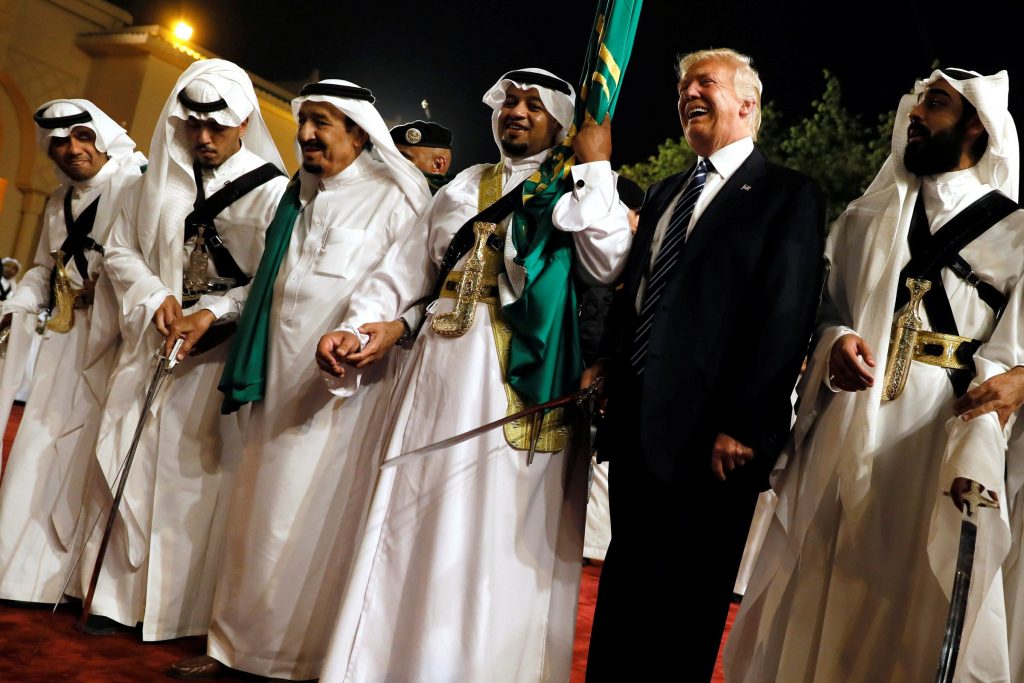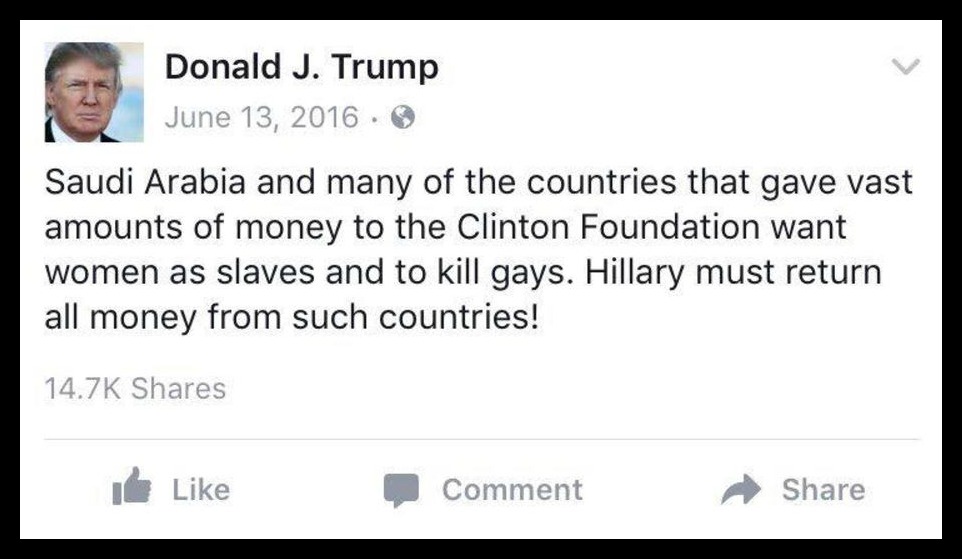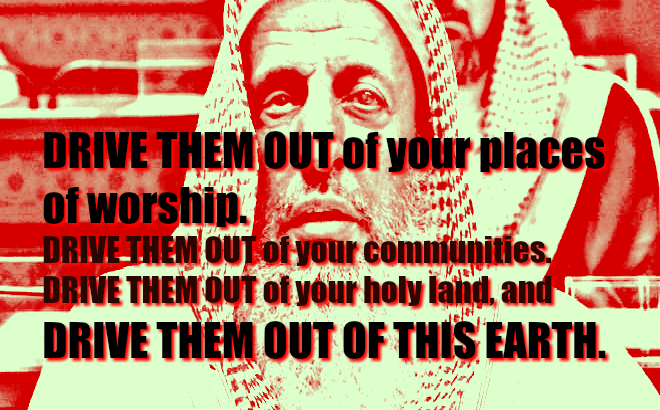Riddled with hypocrisy, clichés and absurdities, President Donald Trump’s speech Sunday before an assembly of monarchs and despots in Saudi Arabia spelled out an agenda of escalating US militarism throughout the Middle East and a buildup in particular toward war with Iran.
Hailed by a fawning American media as “presidential”–supposedly eclipsing for the moment the crises and factional struggles engulfing the administration–the speech was reportedly drafted by Stephen Miller, the extreme right-wing ideologue credited with being the chief architect of Trump’s abortive executive order banning people from seven predominantly Muslim nations from entering the US.
Much in Trump’s half-hour address echoed the speech delivered by Barack Obama in Cairo eight years earlier. Both presidents declared their desire to reset US relations with the Middle East, while absurdly posturing as leaders of a pacifist nation seeking only good for the region and offering to head up a united struggle against “violent extremism.”
In what was meant as a rhetorical invocation to action against terrorism, Trump told his audience,
“Drive them out. Drive them out of your places of worship. Drive them out of your communities. Drive them out of your holy land. And drive them out of this earth.”
Like Obama before him, Trump had no interest in dealing with who brought Al Qaeda and similar forces in, as the historical trail leads directly to the CIA in Afghanistan and US imperialism’s longstanding support for right-wing Islamist organizations and terrorist groups as a counterweight to left nationalist and socialist influence in the Arab and Islamic world. Jointly, the US and Saudi Arabia continue to fund and arm such forces in their drive for regime-change in Syria.
Both speeches were laced with flowery tributes to Islamic culture. Trump noted in particular how impressed he was with the “splendor” of Saudi Arabia and the “grandeur” of the palace in which the so-called Arab Islamic American Summit had been convened.
What separated the two addresses were the different shifts in strategy by Washington. While Obama sought to repair the damage done by the Bush administration’s criminal war in Iraq by offering a new face for US imperialism, Trump traveled to Saudi Arabia to make clear his administration’s break with his predecessor’s policy of seeking a rapprochement with Iran based on the 2015 nuclear deal. He adopted an openly confrontational stance toward Tehran.
“Above all, America seeks peace–not war,” Trump proclaimed, in what stood out as the most blatant of the many lies in his brief address. The reality is that US wars in the region have killed millions over the past decade-and-a-half. And the thrust of the US president’s visit to Saudi Arabia, his first stop in a nine-day foreign tour, is the preparation for new and even bloodier conflicts.
This was made plain by the principal agreements forged between Trump and the Saudi monarchy, which included a $110 billion arms deal that incorporates the option to purchase $350 billion worth of weapons over the next 10 years.
The arms agreement “supports the long-term security of Saudi Arabia and the entire Gulf region,” Secretary of State Rex Tillerson, the former ExxonMobil CEO, told reporters in Riyadh, “in particular in the face of the malign Iranian influence and Iranian-related threats which exist on Saudi Arabia’s borders on all sides.”
In his speech, Trump painted Iran as the principal state sponsor of terrorism, accusing Tehran of providing terrorists with “safe harbor, financial backing, and the social standing needed for recruitment,” and fueling “the fires of sectarian conflict and terror,” all charges that could be leveled, with justification, against his Saudi hosts.
He portrayed the US cruise missile attack on Syria last month–followed just last week by the US bombing of a pro-government militia in the southeastern part of the country–as part of a wider struggle against Iranian influence. He went on to call upon “all nations of conscience” to “isolate Iran, deny it funding for terrorism and pray for the day when the Iranian people have the just and righteous government they deserve.”
That he was speaking in Saudi Arabia, a brutally repressive absolute monarchy, just two days after more than 70 percent of Iranian voters participated in a sharply contested election, did nothing to blunt Trump’s call for regime-change.

Trump sword-dancing. (Photo: Screenshot)
He specifically praised Saudi Arabia and its allies for having “taken strong action against Houthi militants in Yemen.” The near-genocidal Saudi war has killed some 12,000 Yemenis, while destroying basic infrastructure in the Arab world’s poorest country, leaving over 7 million people on the brink of starvation and unleashing a cholera epidemic that threatens a massive death toll.
In March, US Defense Secretary James “Mad Dog” Mattis issued a memo calling for stepped-up US support for this criminal war, in which the Pentagon is already supplying intelligence and logistical backing to the Saudi bombing campaign.
Part of the weapons deal signed by Trump involves the shipment of precision-guided munitions that had been cut off in a highly limited gesture of disapproval of Saudi tactics in Yemen by the Obama administration, which itself concluded over $100 billion worth of weapons deals with Riyadh. Also included in the new deal are tanks, artillery, helicopters and other weaponry that can be directly funneled into the slaughter in Yemen.
In addition to his speech and the signing of arms and investment deals, Trump participated in a meeting of the Gulf Cooperation Council, the Saudi-led coalition of Gulf oil sheikdoms. Trump administration officials have raised the objective of using the GCC as the foundation of a Sunni Arab version of NATO directed at military confrontation with Iran.
Beyond the drive to militarily confront Iran, a principal regional rival of US imperialism in the Middle East, and the huge profits that Saudi arms purchases reap for the US military industrial complex, there are broader strategic considerations in the US turn toward a closer alliance with Riyadh.
Some of these issues were outlined on the eve of Trump’s trip in a piece published by the influential Washington think tank the Center for Strategic and International Studies and authored by Anthony Cordesman, a longtime Pentagon adviser. First among them is, according to Cordesman, “the continued level of US dependence on Saudi help in securing the stable flow of Gulf oil.”
While US imports from the Gulf have fallen sharply over the past quarter-century, Cordesman cites “indirect dependence” in terms of the impact a disruption in oil exports would have on global energy prices and the world capitalist economy. In particular, he points to the dependence of Asian economies on Gulf petroleum exports.
If the United States failed in “providing power projection forces and arms” to the region, he writes, its principal global rival, China, might fill the void. “China may not yet be ready to try to assume the role, but the entire South China Sea crisis would pale to near insignificance if China became the de facto guarantor of Gulf stability.”
Cordesman continues:
“The real-world nature of US influence and power in the Pacific would be cut massively, China’s leverage over other major Asian economies like Japan and South Korea would be sharply increased, and the potential rise in tension between China and India–and cut in India’s relative position–would have a massive impact on the balance of power in South Asia and the Indian Ocean.”
In other words, the turn toward closer relations with Saudi Arabia and the related Gulf oil sheikdoms is bound up with US imperialism’s mounting conflict with China, which it has identified as the principal challenge to the drive for American global hegemony. Washington is determined to dominate Asia, including China, by maintaining the military power to choke off the region’s energy imports.
The fact that the sclerotic House of Saud, one of the world’s last absolute monarchies, has become a lynchpin of Washington’s imperialist strategy, not only in the Middle East but globally, is a measure of the crisis of American and world capitalism.
Oil revenues, which account for fully 90 percent of the kingdom’s export earnings, have been cut nearly in half since 2014. Last month, the government was forced to reverse itself on austerity measures that hit the military and public employees over fear that declining living standards and rising unemployment are creating the conditions for social revolt.
In the predominantly Shia Eastern Province, the center of the kingdom’s oil production, security forces laid siege to the town of Awamiyah, a center of resistance to the regime, during the week preceding Trump’s visit. Combined with the failure of the Saudi bid to topple the Assad regime in Syria by supporting Al Qaeda-linked militias and the regime’s inability to retake Yemen from the Houthi rebels, the deepening domestic crisis is creating the conditions for revolutionary upheavals against Washington’s principal ally in the Arab world.
***
READ MORE TRUMP NEWS AT: 21st Century Wire Trump Files
SUPPORT OUR WORK BY SUBSCRIBING & BECOMING A MEMBER @21WIRE.TV

















